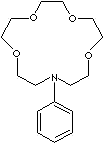|
Crown Ether is a
macrocyclic polyether whose structure contains hydrogen, carbon and oxygen
atoms. Each oxygen atoms are confined between two carbon atoms and exhibits a
conformation with a hole (accordingly called "crown"). The common names of Crown
Ethers have a prefix to designate the total number of atoms in the cycle and a
suffix to designate the number of oxygen atoms in the cycle. For example,
15-crown-5 is composed of 15 atoms in the cycle, 5 of which are O and 10 of
which are C.
As an ether, crown ethers are soluble in non-polar solvents.
They are capable of strong solvency binding cations
in their central cavity. The exterior of the ring is hydrophobic.
The size of
the interior central cavity, fused ring system, and side chains and functional
groups determine the solvency capacity of the cation and
the power of hydrophobic.
The main characteristic of
crown ether is the complexation of the
ether oxygens with various ionic species. If metalic elements pass through the
center of the hole, they stick to oxygen atoms. The crown compound is then
termed "host-guest" chemistry; Crown Ether acts as the "host" taking ionic
species as its "guest". Crown compounds locks guest atoms in a solution and wrap
around it. Crown ethers are used in PTC (phase-transfer catalysts) system and in
encouraging the solubility of inorganic compounds in organic solvents to promote
chemical reaction. 'Host-Guest' chemistry of crown ethers can be a key to
identify the move of essential elements in the body and can play the part of
very complicated biological reactions such as enzyme's functions, which can be
applied to develop new pharmaceuticals. Other compounds that have host
cavity include cyclodextrins, calixarenes, cucurbiturils
and porphyrins..
Cyclen (1,4,7,10-tetraazacyclododecane) is the aza analogues of crown ethers
with repeating (-CH2CH2N) units.
Cyclam is 1,4,8,11-Tetraazacyclotetradecane with repeating (-CH2CH2CH2N) units.
They are starting materials to produce macrocyclic polyamine metal-complexing agents.
They coordinate more than one metal ions in their central cavity.
They are used as a ligand in chemistry for the applications
of diagnostic imaging technique to identify medical condition or disease
and for the development of
medication as a therapeutic agent and pharmaceutic aid.
|
|
Ether is any of a number of organic compounds characterized by an oxygen atom
joined with single bonds by two carbon atoms that are part of hydrocarbon
groups. The general formula is R-O-R', where R and R' are alkyl or aromatic
groups. Ethers are formed by the condensation of two alcohols by heating with
sulfuric acid; the reaction is one of dehydration. Ethers can be prepared from
alkyl halide reacted with metallic alkoxide (called Williamson synthesis).
Ethers are similar to alcohols but are generally less dense, less soluble in
water, and have lower boiling points. They are relatively unreactive, which
makes them valuable solvents. But ethers will be
cleaved at high temperatures by concentrated hydrogen halides. Ethers have relatively low boiling point
compare to alkanes as they don't form hydrogen bonds each other. Ethers are more
lipophilic than esters [R-C(=O)-O-R']or amides [RCO-NH2]. Ethers are widely used as solvents for various organic reactions because they
are relatively the least reactive among common organic compounds except alkanes
and fluorocarbons. The common reaction of ethers is cleavage of the C–O bond by
strong acids either in linear chain or cyclic structure. Ethers in which oxygen
is bonded to primary and secondary alkyl groups can form peroxide compounds in
the presence of gaseous oxygen due to two unpaired electrons in oxygen. Ethers can act as
Lewis bases in chemical reactions. Commonly, ethers are
named simply in listing the alkyl groups in alphabetical order or alkane order
such as ethyl methyl ether or methyl ethyl ether, which is methoxyethane in
IUPAC nomenclature ( the formula of "alkoxyalkane" ). When ether is a
parts of complex molecule or aromatic derivatives, it is described as an alkoxy
substituent such as methoxybenzene ( trivial name is anisole). The methoxy
prefix indicates the function methyl group joined by single bonds to an oxygen atom,
with the general formula -O-CH3. Cyclic ethers
have ring structure where the oxygen has become part of the ring. The term of
epoxide indicate three membered cyclic ether (also called oxirane) in which an
oxygen atom is joined to each of two carbon atoms that are already bonded to
each other; four
membered cyclic ether is called oxetane; five membered cyclic ether, furan (or
oxolane); six membered cyclic ether, pyran (also called oxane) respectively.
Their unhindered oxygen atom carries two unshared pairs of electrons - a
structure which favors the formation of coordination complexes and the solvation
of cations. Cyclic ethers are used as important solvents, as chemical
intermediate and as monomer for ring-opening polymerization. Crown Ether is a macrocyclic polyether whose structure contains
hydrogen, carbon and oxygen atoms. Each oxygen atoms are confined between two
carbon atoms and exhibits a conformation with a hole (accordingly called
"crown"). Anisole is one of the simplest aromatic compound to
which ether group is linked. But
it is different with aromatic compounds like furan where the oxygen is a part of
the ring. Anisole, C6H5OCH3
(methyl phenyl ether), is a clear liquid that is soluble in ether and
alcohol; insoluble in water; boiling point 155 C. Anisole and its derivatives
are used as solvents and in perfumery. Anisole can be obtained from anise seed.
Anisic acid, p-methoxybenzoic acid, is a part of cresol class antiseptic
compounds. It
is also used as an insect repellent and ovicide.
Anisole, anisic acid, and their derivatives are also widely used in
chemical reaction as intermediates to obtain target materials such as dyes,
pharmaceuticals, perfumes, photoinitiators and agrochemicals. |
